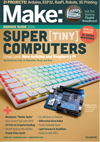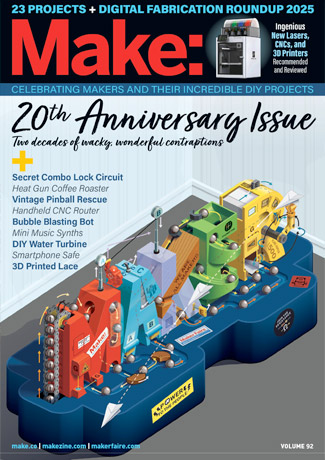

Why old chemistry sets were better — and how to make your own today.
It’s true: chemistry sets today don’t measure up to the classic kits that once scorched Formica kitchen tables across the nation. But you can still find respectable kits if you know where to look. More importantly, anyone can make their own flaming, fuming, booming DIY chemistry set as good as those from the golden age — or better.
Danger Is My Middle Name
How good were the old sets? They were certainly more exciting, stocked with iodine and nitrates good for making unstable explosives or homemade rocket motors. Chlorine and cyanide compounds could emit deadly gases. A few chemicals turned out to cause cancer.
Kits from the 1920s to the 60s might include radioactive uranium, deadly sodium cyanide, or pure magnesium foil that burns at 4,000°F, with manuals that told how to mix up gunpowder or melt sand red-hot to blow your own glass test tubes. The Golden Book of Chemistry Experiments debuted in 1960, packed with risky experiments. Its 19th-century predecessor, The Boy’s Own Book, had 20-plus pages of chemistry and fireworks recipes.
People tolerated more risk back then, but in exchange, generations of young experimenters were rewarded with deeper discoveries, bigger thrills, and the satisfaction of daring to achieve something important for the future.
Rocketry, nuclear energy, plastics — new sciences that were changing the world — were all highlighted in popular chemistry sets of the mid-20th century. Many of today’s scientists and engineers trace their careers back to the excitement of that first set.
Kits Today: Wimpified
Compared to their robust ancestors, chemistry sets today are wimpy. They revolve around low-energy reactions and the quiet creation of crystals and polymers. The average set from the mall has no burner to provide a flame, no chemicals that go bang. It’ll let you prepare solutions that change colors or glow like a light stick, but that’s about it for excitement.
Why? It’s common sense to delete highly toxic compounds, and we’re certainly more focused these days on insulating kids from risk.
But mostly it’s fear: of liability, of terrorists, of the neighbors. Overreacting to methamphetamine trafficking, Texas has outlawed the Ehrlenmeyer flask. In August, panicky Massachusetts police ransacked the basement lab of retired chemist Victor Deeb, who was simply fiddling with experiments in his home.
A Few Good Kits
But not every kit maker has chickened out. Thames and Kosmos of Portsmouth, R.I., sells the Chem C3000, a tolerably well-stocked set with extra bottles for risky stuff like hydrochloric acid and sodium hydroxide, which you’re encouraged to purchase separately.
But if you really want to do chemistry at home, you’ll want to make your own DIY chemistry set. Elemental Scientific sells kits of chemicals, glassware, and lab equipment selected specifically to accompany MAKE author Robert Bruce Thompson’s Illustrated Guide to Home Chemistry Experiments. To learn more, get the book at makershed.com.
DIY CHEMISTRY: Then and Now
We asked author Robert Bruce Thompson about the powerful stuff in classic chemistry sets that’s missing today — and where you can get it.
Mr. Wizard’s Experiments in Chemistry, Set MW-073
Owens-Illinois, Inc., Toledo, Ohio, 1973
“Exciting and Fun”
Iodine, I2 “Iodine is now a Drug Enforcement Administration List I material, which means it’s no longer readily available, and paperwork is required,” says Thompson. The only exception is for 1 fluid ounce or less of iodine solution that contains 2.2% or less of iodine.
»DIY: “You can make your own iodine crystals from potassium iodide (KI).”
“Mystery Powder”
This was reportedly sucrose and acetylsalicylic acid, i.e. sugar and aspirin.
2,4-Dichlorophenol, C6H4Cl2O
A toxic ingredient in herbicides and pesticides, it’s a suspected carcinogen and endocrine disruptor. “A common precursor for industrial-scale syntheses, it’s a chemical with few or no uses in a home lab,” Thompson says.
»DIY: It’s a mystery.
Photography courtesy of Chemical Heritage Foundation
The BGL Chemical Set
B.G. L. Limited, London, England, 1930s
“Perfectly Harmless!”
Lead acetate aka sugar of lead, Pb(C2H3O2) 2
A highly toxic compound used as a sweetener in ancient Rome, it’s hard to believe this was in kids’ sets, but here it is — sold by the British Gas Light Company.
»DIY: Textile, dye, and alternative photography
suppliers.
Sodium hydroxide aka caustic soda or lye, NaOH
Not really kids’ stuff either. Extremely corrosive, it burns skin on contact. It reacts with acids violently, with metals to produce flammable hydrogen gas, and with sugars to form deadly carbon monoxide gas.
»DIY: Sold at hardware stores as crystal drain cleaner (check the label to make sure it’s pure).
Chemcraft Chemical Outfit No. 1
Porter Chemical Co., Hagerstown, Md., 1917
“Perfectly Safe. Contains No Poisonous Or Otherwise Harmful Substances”
Potassium nitrate, KNO3
Sulfur, S8
Gunpowder precursors were common in chemistry sets before about 1940. Black powder is potassium nitrate (saltpeter), carbon (charcoal), and sulfur mixed in the correct proportions (see MAKE, Volume 13, “The Fire Drug”).
“Potassium nitrate and table sugar, if processed and mixed properly, can form a low explosive that’s used for amateur rocket motors (“rocket candy”),” says Thompson. “Otherwise they simply form a very combustible mixture that burns fiercely and generates a lot of smoke (smoke bombs). In today’s sets, sulfur is still common — but not potassium nitrate.”
»DIY: Charcoal you can get anywhere. Potassium nitrate is sold as a fertilizer (14-0-45 or 13-0-46), and sulfur is sold in lawn and garden stores to control plant pests and diseases.
Ammonium nitrate, NH4NO3
Explosive, it’s used in fertilizer bombs like the one that destroyed the federal building in Oklahoma City in 1995.
»DIY: Sold at lawn and garden or farm supply stores as 34-0-0 fertilizer.
Strontium nitrate, Sr(NO3) 2
Extremely volatile, it’s used to color fireworks. When heated, it releases toxic nitrogen dioxide gas.
» DIY: Chemical supply companies.
Photography courtesy of Chemical Heritage Foundation; by Dustin Fenstermacher (second from top)
Gilbert Chemistry Set
A.C. Gilbert Co., New Haven, Conn., 1920s
“Today’s Adventures in Science Will Create Tomorrow’s America”
Sodium cyanide, NaCN
Erector Set inventor A.C. Gilbert actually sold kids this chemistry set with sodium cyanide, the stuff of suicide capsules and murder most foul. “Deadly stuff in pretty small doses,” says Thompson, “just like potassium cyanide. It also reacts with acids to form hydrogen cyanide gas, which is also deadly. This isn’t something kids should be messing with. It’s so toxic that it’d have been insane to include it, even back when things were a lot more relaxed.”
»DIY: It’s sold by some photography suppliers, but its transport is heavily regulated.
Gilbert No. U-238 Atomic Energy Lab
A.C. Gilbert Co., New Haven, Conn., 1950s
“Most Modern Scientific Set Ever Created!”
Radioactive uranium ores, UO2 and others
These 4 small samples of carnotite, autunite, torbernite, and uraninite emitted alpha, beta, and gamma radiation. The set also had a Geiger counter, a cloud chamber to see the paths of alpha particles, and an electroscope and spinthariscope for detecting radioactivity and decay.
»DIY: “Readily available,” says Thompson. “United Nuclear sells small chunks of various (slightly) radioactive ores and minerals. They present no real danger, although they shouldn’t be ingested and it’s a good idea to handle them only with gloves and tongs.”
Photography courtesy of A.C. Gilbert’s Discovery Village
Gilbert Chemistry Set
A.C. Gilbert Co., New Haven, Conn., c. 1920s
Glass blowing kit
A.C. Gilbert strikes again. Sand (silicon dioxide) melts at 3, 100°F. But if you add soda ash (sodium carbonate) and powdered limestone (calcium carbonate), it melts into glass at just 1,600°F. Still, that’s 1,600°F, kids. Mind your fingers.
»DIY: Readymade lab glassware is sold by suppliers like Elemental Scientific (see Resources).
Porter Chemcraft Master Chemistry Lab No. 616 featuring Atomic Energy
Porter Chemical Co., Hagerstown, Md., 1950s
“Modern Plastic Experiments. Outer Space Experiments”
Radioactive uranium ore
See Gilbert No. U-238.
Carbon tetrachloride, CCl4
Nickel ammonium sulfate, Ni(NH4) 2(SO4) 2·6H2O
Both are likely carcinogens, banished from chemistry sets today. Neither is particularly dangerous to handle, says Thompson, if you take proper precautions to avoid fumes or dust, prevent skin contact, and so forth.
»DIY: Readily available from chemical suppliers such as Elemental Scientific and Home Science Tools — see Resources, below.
Photography courtesy of Chemical Heritage Foundation
Calcium hypochlorite, Ca(ClO) 2
A strong oxidizer, it’s been known to undergo self-heating and rapid decomposition, releasing toxic chlorine gas. “Frankly, I see little use for this chemical in a home lab,” says Thompson. “For most purposes you can substitute the much safer sodium hypochlorite solution sold in grocery stores as chlorine bleach.”
»DIY: Sold as pool and spa “shock” treatment; use bleach instead.
Dustin Fenstermacher
Sodium ferrocyanide, Na4Fe(CN) 6
Ferrocyanide salts react with iron(III) (ferric) ions to produce the intense pigment Prussian blue, so they’re a great test for the presence of ferric ions. “Despite the ‘cyanide’ in the name, these salts are relatively nontoxic and safe to handle,” says Thompson. “Heating them to decomposition or treating them with a strong mineral acid does produce hydrogen cyanide gas, which is deadly in significant amounts. Technically, these salts are considered poisons, but they’re not really dangerous if handled with normal precautions.”
» DIY: Chemical suppliers. For most purposes, you can substitute the more readily available potassium ferrocyanide, K4[Fe(CN) 6], also available from photography darkroom suppliers.
Dustin Fenstermacher
RESOURCES
» Chemical and equipment suppliers:
Elemental Scientific elementalscientific.net
Home Science Tools homesciencetools.com
Science Kit sciencekit.com
United Nuclear unitednuclear.com
Edmund Scientific scientificsonline.com
» Alternative sources for chemicals:
hyperdeath.co.uk/chemicals
» Chemical Heritage Foundation:
stage.makezine.com/go/chemheritage
ADVERTISEMENT














